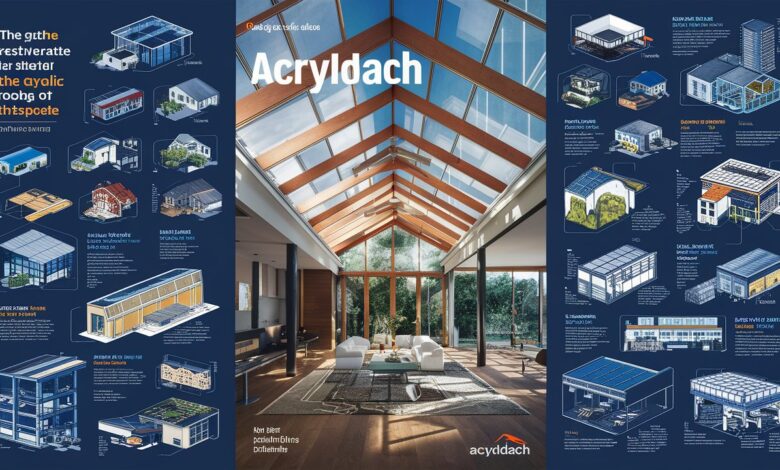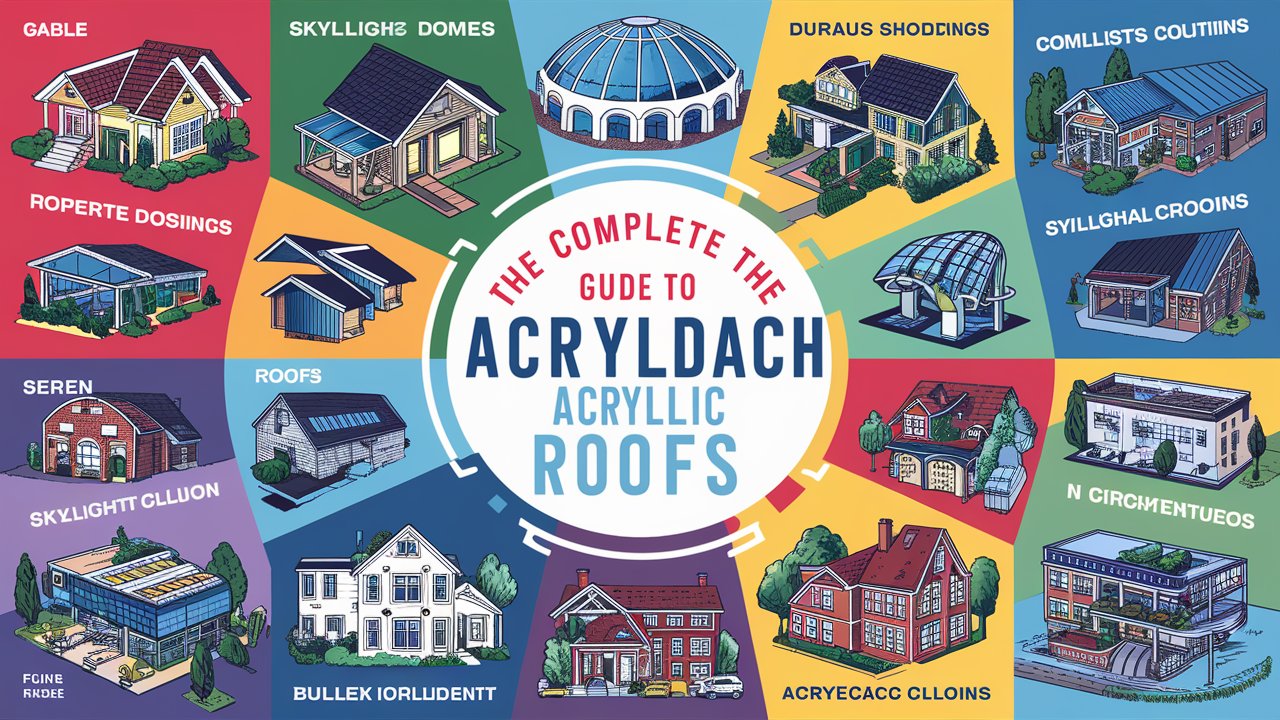Acryldach – The Complete Guide to Acrylic Roofs for Durability and Style

An Acryldach, or acrylic roof, has become one of the most sought-after roofing solutions in modern architecture. Known for its exceptional durability, high light transmission, weather resistance, and aesthetic appeal, an acrylic roof is ideal for residential, commercial, and industrial applications. Unlike traditional roofing materials, an Acryldach offers a perfect balance of strength and transparency, making it a versatile choice for both functionality and design. In this article, we will explore the benefits, installation methods, maintenance tips, costs, and applications of acrylic roofs in detail.
What is an Acryldach?
An Acryldach is a roofing system constructed using acrylic sheets, a strong thermoplastic material known for its lightweight nature and outstanding impact resistance. Acrylic sheets used in roofing are often UV-resistant and available in various thicknesses, colors, and finishes. This makes them suitable for diverse projects ranging from carports, greenhouses, skylights, pergolas, patios, and industrial sheds.
The key feature of an acrylic roof lies in its light transmission properties, which can reach up to 92%, allowing natural light to illuminate interiors while still providing excellent weather protection. Unlike glass, acrylic is ten times stronger yet significantly lighter, making it safer and easier to handle.
Advantages of Acryldach
1. High Durability and Weather Resistance
Acrylic roofing sheets are engineered to withstand harsh weather conditions, including heavy rain, hail, snow, and extreme UV radiation. They do not corrode, making them a long-lasting alternative to metal or wood roofing.
2. Superior Light Transmission
One of the most significant benefits of an Acryldach is its natural light permeability. Acrylic sheets allow maximum sunlight to enter, reducing the need for artificial lighting during the day and creating bright, welcoming spaces.
3. Lightweight and Easy to Install
Unlike glass or concrete, acrylic is lightweight, which simplifies installation and reduces structural load on the building. This makes it an excellent choice for both new constructions and retrofitting projects.
4. Versatility in Design
Acryldach systems are available in various designs, colors, and finishes, enabling architects and homeowners to achieve modern, sleek, and aesthetic looks. Whether you prefer clear sheets for maximum transparency or tinted sheets for shade and privacy, the options are nearly limitless.
5. Cost-Effective and Low Maintenance
While offering premium benefits, acrylic roofs are relatively affordable compared to glass or polycarbonate alternatives. They require minimal upkeep, usually limited to periodic cleaning to maintain clarity and brightness.

Applications of Acryldach
Residential Applications
An Acryldach is commonly used in carports, garden terraces, balconies, and patios, offering homeowners a stylish way to enjoy outdoor spaces while being protected from rain and sun.
Commercial Applications
Businesses often install acrylic roofing in cafés, restaurants, and retail outlets, where natural lighting creates a warm and inviting atmosphere while reducing electricity costs.
Industrial Applications
Factories and warehouses benefit from Acryldach skylights, which provide natural illumination and improve working conditions while cutting down on energy expenses.
Greenhouses and Conservatories
Due to its UV resistance and light permeability, acrylic roofing is widely used in greenhouses and plant conservatories, ensuring healthy plant growth while protecting against harsh weather.
Types of Acrylic Roofs
Clear Acrylic Roofs
These allow the highest level of light transmission, ideal for greenhouses, patios, and skylights.
Tinted Acrylic Roofs
Available in bronze, grey, or blue shades, tinted sheets reduce glare and heat while maintaining brightness.
Textured Acrylic Roofs
These provide privacy while still allowing light diffusion, perfect for balconies or semi-private outdoor areas.
Multi-Wall Acrylic Sheets
Featuring multiple layers, these provide extra insulation and strength, suitable for industrial and commercial roofing projects.
Installation of Acryldach
Proper installation is key to ensuring the longevity and performance of an acrylic roof. The process typically involves:
-
Measuring and Cutting Sheets – Acrylic sheets are cut to fit the roof dimensions precisely.
-
Framing Support Structure – A sturdy metal or wooden frame is built to support the lightweight sheets.
-
Fixing Sheets – Sheets are mounted with screws and sealed with rubber gaskets to prevent leaks.
-
Weatherproofing – Edges and joints are sealed with silicone to enhance water resistance.
Professional installation is recommended to avoid issues like cracking or misalignment.
Maintenance of Acryldach
Acrylic roofs require minimal maintenance, but a few steps can prolong their clarity and strength:
-
Regular Cleaning with mild soap and water to remove dust, bird droppings, or debris.
-
Avoid Harsh Chemicals or abrasive cleaners that could scratch the surface.
-
Inspect Joints and Seals annually to ensure there are no leaks.
-
Polishing Options are available if the surface becomes dull over time.
With these practices, an acrylic roof can last for 20 years or more without losing its appeal.
Cost of Acryldach
The cost of installing an Acryldach varies depending on the type of acrylic sheet, thickness, roof size, and installation complexity. On average, acrylic roofing is more affordable than glass yet slightly more expensive than polycarbonate. However, its long lifespan, clarity, and durability make it a cost-effective investment in the long run.
Acryldach vs. Other Roofing Materials
-
Acryldach vs. Glass – Acrylic is lighter, stronger, and more impact-resistant than glass while offering similar transparency.
-
Acryldach vs. Polycarbonate – While polycarbonate is more impact-resistant, acrylic provides better clarity, UV stability, and scratch resistance.
-
Acryldach vs. Metal Roofs – Metal roofs are durable but block natural light, whereas acrylic combines durability with excellent light transmission.
Conclusion
An Acryldach is a modern roofing solution that combines durability, style, and functionality. Its ability to let in natural light while withstanding harsh conditions makes it a preferred choice for residential, commercial, and industrial projects. With proper installation and minimal maintenance, an acrylic roof can serve for decades while enhancing the beauty and efficiency of any space.
FAQs About Acryldach
Q1: How long does an Acryldach last?
An acrylic roof can last up to 20–30 years with proper care and maintenance.
Q2: Is acrylic roofing resistant to hail and snow?
Yes, acrylic sheets are impact-resistant and weatherproof, making them suitable for all climates.
Q3: Can I install an Acryldach myself?
While possible, professional installation is recommended for best results and long-term performance.
Q4: Does an acrylic roof yellow over time?
High-quality UV-protected acrylic sheets resist yellowing and maintain clarity for many years.
Q5: Is an Acryldach more expensive than polycarbonate?
Slightly, but acrylic offers better clarity and aesthetics, making it worth the investment.



